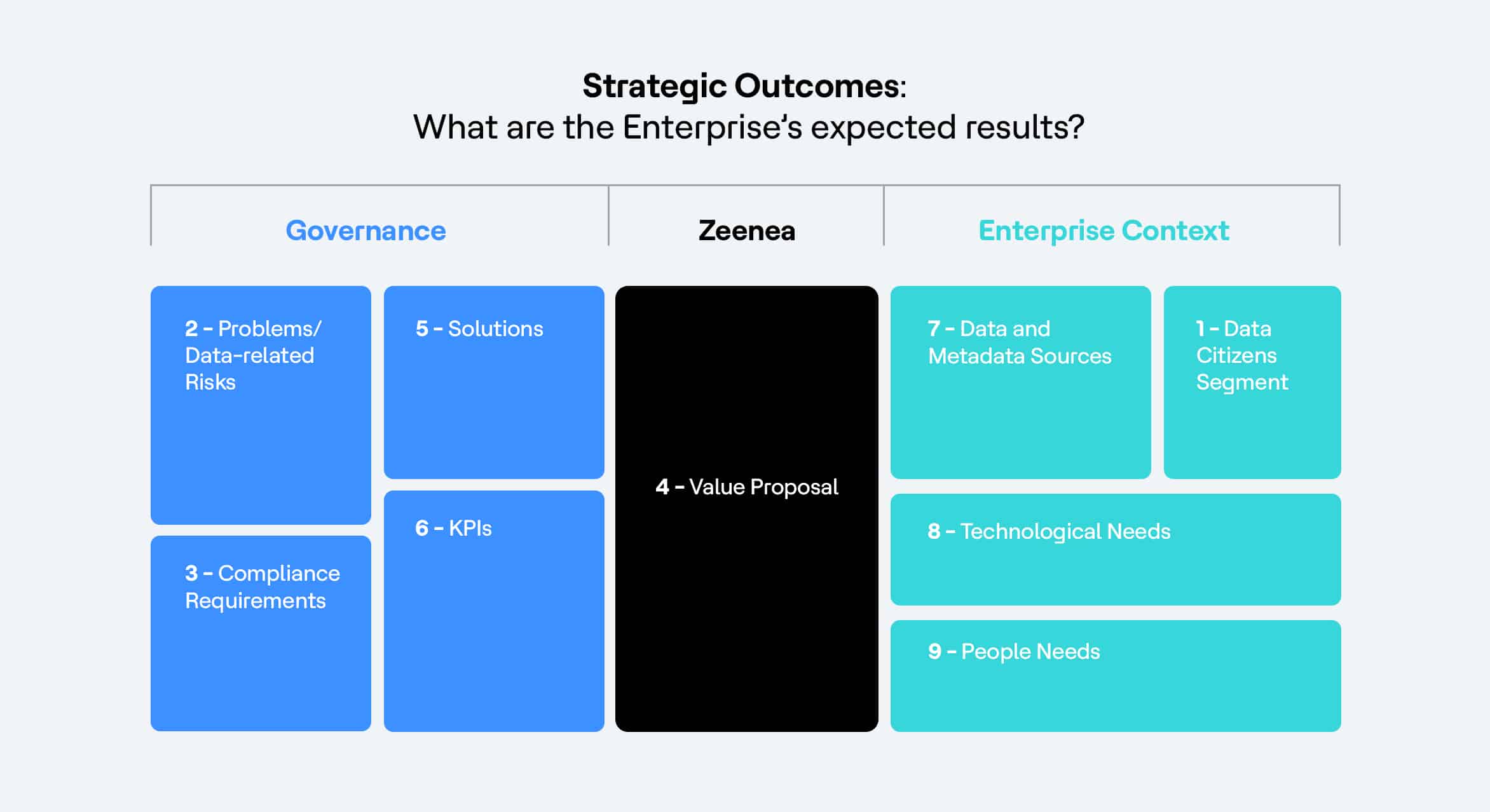Data Governance Tool: Lean Data Governance Canvas
Actian Corporation
June 30, 2020

Inspired by Ash Maurya’s “Lean Canvas” business model, the Actian Data Intelligence Platform’s Lean Data Governance Canvas is intended for Data Managers whose missions are to clarify and orchestrate data governance within their organizations. From a methodological point of view, the Lean Data Governance Canvas is composed of two main parts:
- The elements on the left represent those of a governance system.
- The elements on the right that are inherent to an organization.
It’s important to know that this Lean Data Governance Canvas is a toolkit for implementing data governance. The intervenors will have to iterate to conduct an LDGC to have the least number of assumptions as possible over time.
However, be aware: there must not be one unique canvas that represents the entirety of the enterprise, but rather, there must be separate ones for strategic and operational levels.
The insights highlighted in the Lean Canvas will have to be consistent and respect the company’s strategic objectives.
Method: Lean Data Governance Canvas
0 – Strategic Objectives
Before beginning your journey with the Lean Data Governance Canvas, it is important to highlight the enterprise’s strategic expectations and ask yourself:
What are the enterprise’s and the board’s strategic objectives? How does it apply to the data and IT department?
1 & 2 – Segment Data Citizens & Problems
Start by thinking about a type of persona. After this, you can take the time to come up with up to 3 challenges that this group faces:
Who are the data citizens you wish to address?
What are the top 3 problems/ risks that data governance seeks to solve for the defined data citizen segment?
Your data citizens are either the ones in charge of your data governance (Data Owners, Data Managers, IT Custodians, etc.) or the producers/consumers of data (Management, Supply-chain, CRM, Data Science, Marketing, etc). Your risks may concern one or more of these personas.
3 – Regulatory Compliance
Digital transformation brings about more regulatory compliances (like the GDPR for example). To keep your constraints in mind, write down your regulatory requirements and ask yourself this question:
What are the risks stemming from regulatory (including supervisory) requirements?
4 – Value Proposition
This part of the LDGC focuses on the value that data governance will bring to the segmented data citizens.
Why push back data governance implementation for the defined data citizen segments?
The value proposition is unique, congruent and engaging for concerned data citizens. Communication or marketing support can sometimes be a valuable aid in formalizing a value proposition. Do not hesitate to get closer to the relevant internal teams.
5 – Solutions
In this section, the means and principles are defined, ones that will make it possible to overcome the problems of your data citizen segments and veer towards the value proposition. Without going into too much detail:
What are the 3 main principles that will answer the data citizen segments problems?
In this Canvas, a solution must not take into account what already exists and is not determined according to time or budget. The Canvas is not a project of timing, but an upcoming project that must be considered as an MVP (minimum viable product) for a first milestone.
6.1 – Targeted Metrics
These indicators define the performance of the established data governance in the data citizen segment. They will measure the resolution of the problem and the value of your governance rules.
What key indicators should be measured to validate the progress of the sought-out value proposition?
6.2 – Connectivity Metrics
These metrics are indicators that define the implemented data governance performance on the sources of information that your previously listed.
What key indicators should be measured to validate the performance of the data governance rules on a source?
7 – Data Sources
What are the “absolutely necessary” data sources that will bring the most value at the start of your defined data citizen segments?
Data sources are valuable assets for data-centric teams. The goal therefore, is to find the value. Mass-production and exhaustiveness induce an immediate complexity that can not be easily controlled. The choice must be made based on the data’s value according to the uses of business.
8 – Technological Needs
Identify the technological needs that must be acquired to measure governance metrics and/or achieve the value proposition.
What are the technologies and tools needed to measure the associated metrics?
9 – People Needs
Identify the skills and resources to bring data governance to life, animate and measure it within the targeted data segment.
Who are the people concerned and what tips and interactions are necessary to strive for the value proposition and its maintenance?
The Evolution of the Lean Data Governance Canvas Over Time
After focusing on these first steps, it is important to test it! We encourage Lean Data Governance Canvas users to rework the canvas as much as possible – through iteration – and testing them, after which a winning data governance model should appear. Despite the difficulty of these workshops, we are convinced that this work will save you time, energy and money. Think about it, with thee Lean Data Governance Canvas, it is possible to build something everyone in the enterprise wants and respects.
Subscribe to the Actian Blog
Subscribe to Actian’s blog to get data insights delivered right to you.
- Stay in the know – Get the latest in data analytics pushed directly to your inbox.
- Never miss a post – You’ll receive automatic email updates to let you know when new posts are live.
- It’s all up to you – Change your delivery preferences to suit your needs.
